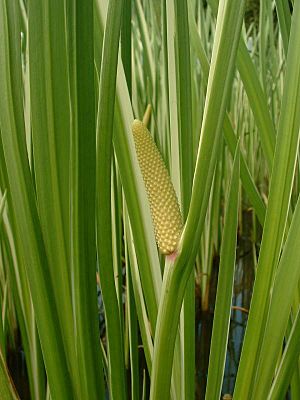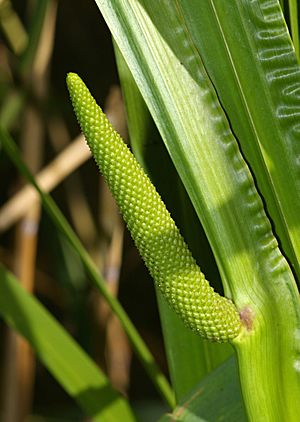Sweet flag facts for kids
Quick facts for kids Sweet flag |
|
|---|---|
 |
|
| Sweet flag | |
| Conservation status | |
| Scientific classification | |
| Genus: |
Acorus
|
| Species: |
calamus
|
| Synonyms | |
|
Calamus aromaticus Garsault |
|
Acorus calamus, often called sweet flag or calamus, is a type of flowering plant. It's a tall plant that loves wet areas, like marshes and swamps. People have used sweet flag in traditional medicine for hundreds of years to help with stomach problems and pain. However, scientists haven't found strong proof that it's safe or works well. Eating sweet flag can even be harmful, which is why it's not allowed in foods in the United States.
Contents
What Does Sweet Flag Look Like?
Sweet flag is a plant that grows back every year. It can reach up to 2 meters (about 6.5 feet) tall. Its leaves look a bit like those of the iris plant.
The plant has groups of leaves that grow from a root system called a rhizome. These leaves are yellowish-brown and stand upright. They are shaped like swords, flat and narrow, and come to a sharp point. You can tell sweet flag apart from similar plants because its leaves have wavy edges. Also, if you crush a leaf, it gives off a sweet smell.
Sweet Flag Flowers
Only sweet flag plants that grow in water will produce flowers. The flower stems are solid and triangular. A special flower part called a spadix grows from the side of the stem. This spadix is solid, shaped like a cylinder, and is about 5 to 10 centimeters (2 to 4 inches) long.
Many tiny, greenish-yellow flowers grow closely together on the spadix. Each flower has six petals and six stamens. These flowers have a sweet smell. In Europe, sweet flag flowers for about a month in late spring or early summer. However, it usually doesn't produce fruit there. In Asia, it also fruits rarely. The plant mostly spreads by its rhizomes growing and forming new plants.
Sweet Flag Roots
The rhizome, or underground stem, of sweet flag is branched and bumpy. It's about the thickness of a human finger. Many rough, stringy roots grow from it. The outside of the rhizome is brown, and the inside is white.
Where Does Sweet Flag Grow?
Sweet flag can be found in India, central Asia, southern Russia, Siberia, and Europe. It likes to grow along the edges of small lakes, ponds, and rivers. You can also find it in marshes, swamps, and other wet areas.
Names and History of Sweet Flag
Sweet flag has many common names. Some of these include beewort, calamus root, flag root, and sweet rush.
The name Acorus comes from the Latin word acorus. This word comes from an ancient Greek word that might mean "pupil of an eye." This is because juice from the root was once used to treat eye problems.
The name calamus comes from the Greek word for "reed." The name "sweet flag" refers to its sweet smell and how it looks like iris plants, which are often called "flags."
Sweet Flag Through Time
Sweet flag was mentioned in an ancient Egyptian papyrus from around 1300 BC. The Egyptians used it to make perfumes, but not often for medicine.
For a long time, people in Europe confused sweet flag with a similar plant called yellow iris. Early books about plants sometimes showed pictures of the iris but called it Acorus.
True sweet flag was brought to Britain in the late 1500s. A gardener named John Gerard grew it in his garden by 1596. He noted that it grew well but didn't produce flowers or stalks for him. Native American tribes also used the plant.
Different Types of Sweet Flag
Scientists have found different forms of sweet flag based on their chromosomes. The most common form is called triploid. This form is found all over Europe, Australia, and North America. It likely came from the Himalayan region.
There are also diploid and tetraploid forms. The tetraploid form is native to Asia. The diploid form is found in northern North America and parts of Asia. These different forms can look very similar, making them hard to tell apart just by looking.
The triploid form of sweet flag cannot produce seeds. It can only spread by its rhizomes growing.
What's Inside Sweet Flag?
The leaves and roots of sweet flag contain a special oil. This oil gives the plant its unique smell and taste. This oil contains different chemicals, including beta-asarone. The types of chemicals in the plant can change based on where it grows, how old it is, and the climate. Interestingly, the diploid forms of sweet flag do not contain beta-asarone.
Is Sweet Flag Safe?
The United States Food and Drug Administration (FDA) banned sweet flag and its products from being used in human food in 1968. This is because it has not been fully studied to prove it is safe.
Why Sweet Flag Can Be Harmful
Even though sweet flag has been used for its smell and sometimes eaten, scientists haven't done enough research to know if it's truly safe. Some people who have eaten it reported feeling very sick, with severe nausea and vomiting for many hours. Studies in labs show that parts of the plant can be harmful, mainly because of a chemical called beta-asarone, which can cause vomiting.
How People Use Sweet Flag
Sweet flag has been traded and used by many cultures for centuries.
Traditional Uses
- It has been used in traditional medicine for many different health problems, like stomach issues and pain.
- The essential oil from its roots is used in the perfume industry because of its nice smell.
- In Europe, the essence from the root was used to flavor foods, alcoholic drinks, and bitters. It was even used to make candy a long time ago.
Sweet Flag as Food
The young stems of sweet flag can be eaten raw if they are less than 30 centimeters (about 12 inches) tall. The roots can be cleaned, peeled, and boiled in syrup to make a type of candy.
In Herbal Medicine
Sweet flag has a very long history of use in Chinese, Nepalese, and Indian herbal traditions. The leaves, stems, and roots are used in various traditional medicines. Many Indigenous peoples, like the Chipewyan people, also use sweet flag as an herbal medicine.
Gardening with Sweet Flag
Sometimes, sweet flag is grown in gardens as a pond plant. There is a special type of sweet flag grown for its looks, often called 'Variegatus'.
Images for kids
See also
 In Spanish: Cálamo aromático para niños
In Spanish: Cálamo aromático para niños





